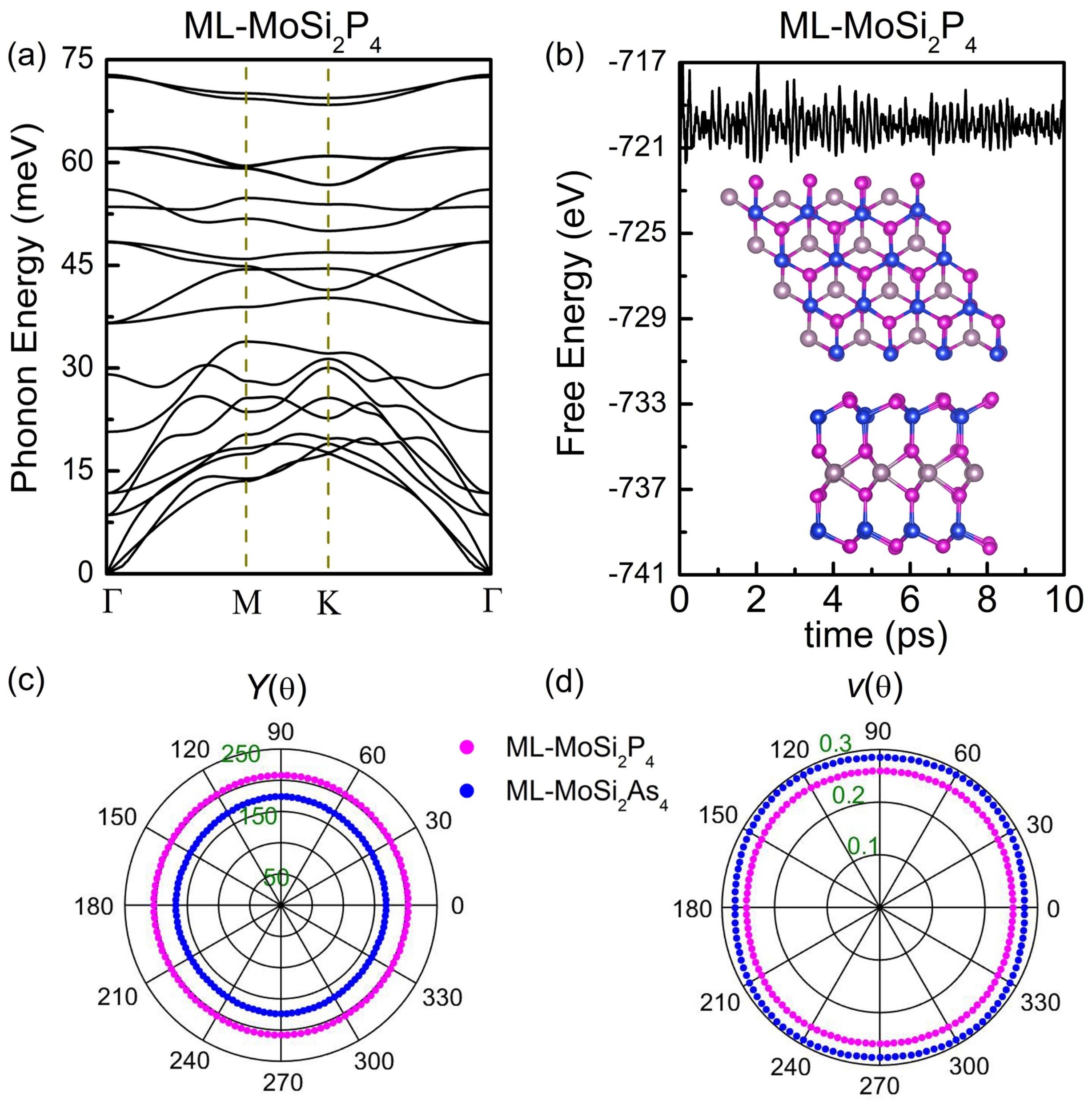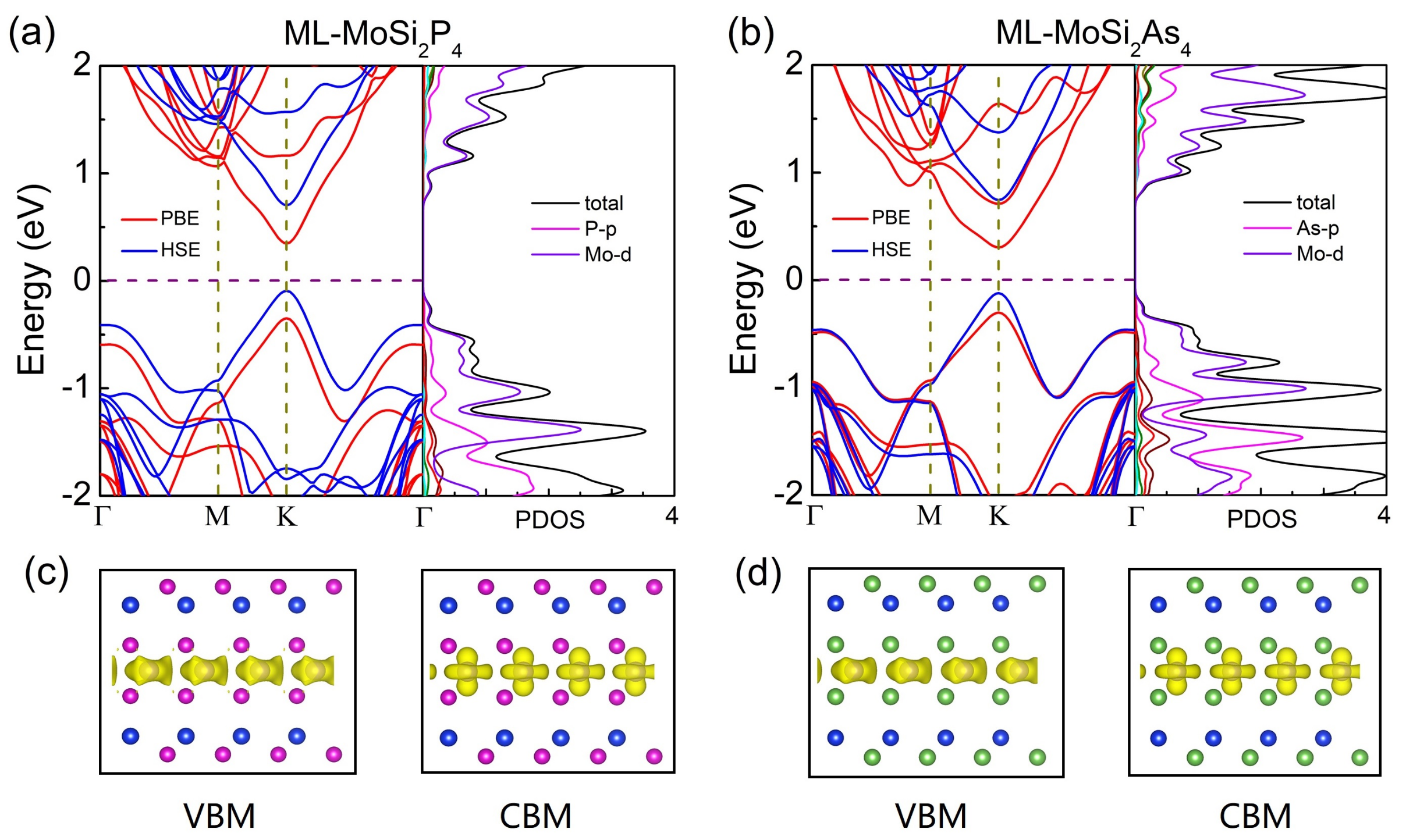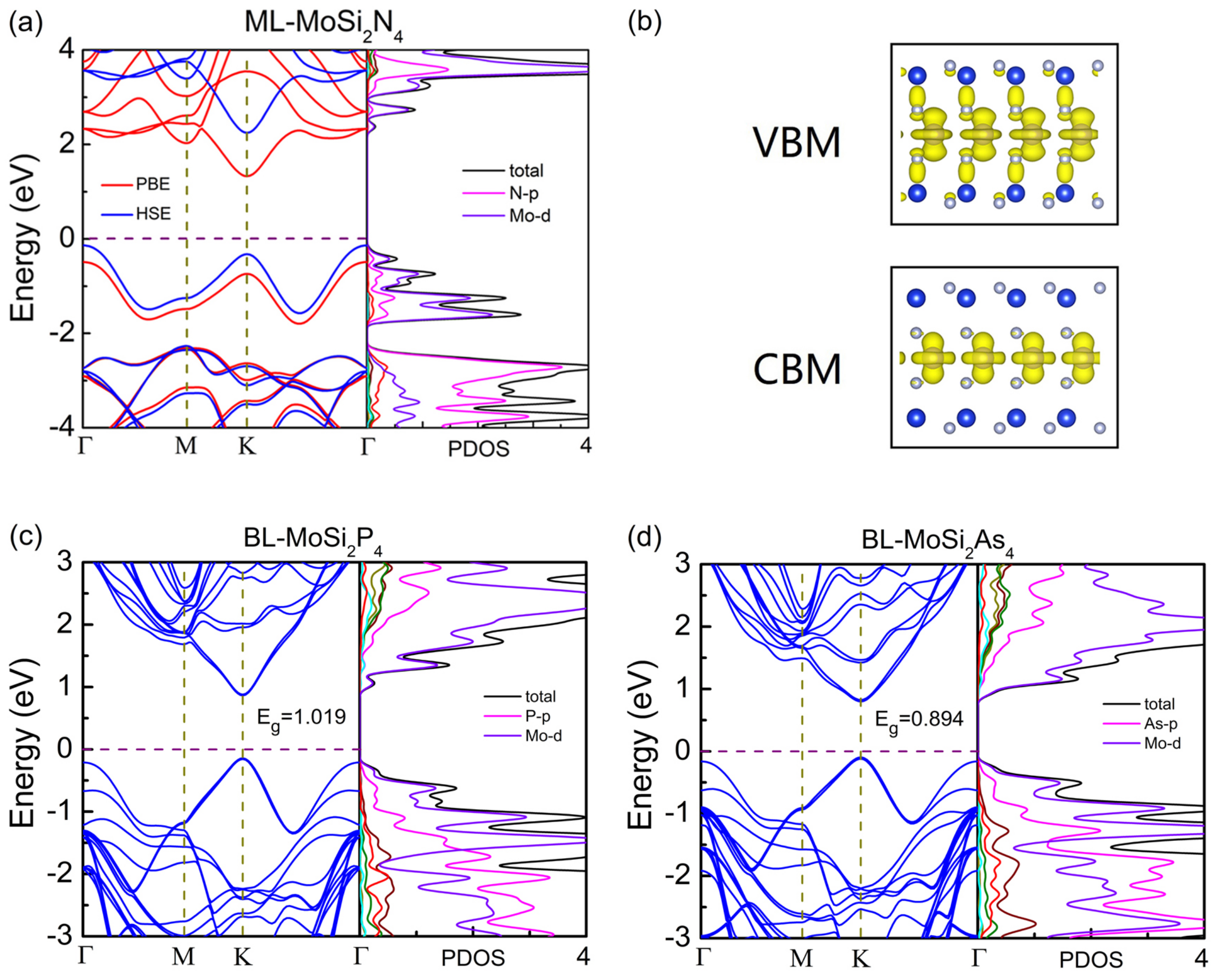Novel Two-Dimensional Layered MoSi2Z4 (Z = P, As): New Promising Optoelectronic Materials
Abstract
:1. Introduction
2. Numerical Methods
3. Results and Discussion
3.1. Structural and Mechanical Properties of Few-Layer MoSiZ (Z = P, As)
3.2. Electronic Properties of Few-Layer MoSiZ
3.3. Carrier Mobilities of Few-Layer MoSiZ
3.4. Optical Absorption Spectrums of Layered MoSiZ
3.5. Photocurrent in Monolayer MoSiZ Nanodevice
4. Conclusions
Author Contributions
Funding
Institutional Review Board Statement
Informed Consent Statement
Data Availability Statement
Conflicts of Interest
References
- Novoselov, K.S.; Geim, A.K.; Morozov, S.V.; Jiang, D.; Zhang, Y.; Dubonos, S.V.; Grigorieva, I.V.; Firsov, A.A. Electric field effect in atomically thin carbon films. Science 2004, 306, 666–669. [Google Scholar] [CrossRef] [Green Version]
- Ci, L.; Song, L.; Jin, C.; Jariwala, D.; Wu, D.; Li, Y.; Srivastava, A.; Wang, Z.F.; Storr, K.; Balicas, L.; et al. Atomic Layers of Hybridized Boron Nitride and Graphene Domains. Nat. Mater. 2010, 9, 430. [Google Scholar] [CrossRef]
- Wang, Q.H.; Kalantarzadeh, K.; Kis, A.; Coleman, J.N.; Strano, M.S. Electronics and optoelectronics of two-dimensional transition metal dichalcogenides. Nat. Nanotechnol. 2017, 7, 699–712. [Google Scholar] [CrossRef]
- Hu, Z.Y.; Ding, Y.C.; Hu, X.M.; Zhou, W.H.; Yu, X.C.; Zhang, S.L. Recent progress in 2D group IV-IV monochalcogenides: Synthesis, properties and applications. Nanotechnology 2019, 30, 252001. [Google Scholar] [CrossRef]
- Xu, K.; Yin, L.; Huang, Y.; Shifa, T.A.; Chu, J.W.; Wang, F.; Cheng, R.Q.; Wang, Z.X.; He, J. Synthesis, properties and applications of 2D layered MIIIXVI(M= Ga, In; X=S, Se, Te) materials. Nanoscale 2016, 8, 16802–16818. [Google Scholar] [CrossRef]
- Yu, T.; Zhao, Z.Y.; Sun, Y.H.; Bergara, A.; Lin, J.Y.; Zhang, S.T.; Xu, H.Y.; Zhang, L.J.; Yang, G.C.; Liu, Y.C. Two-dimensional PC6 with direct band gap and anisotropic carrier mobility. J. Am. Chem. Soc. 2019, 141, 1599–1605. [Google Scholar] [CrossRef]
- Niedzielski, B.; Jia, C.; Berakdar, J. Supercurrent Induced by Chiral Coupling in Multiferroic/Superconductor Nanostructures. Nanomaterials 2021, 11, 184. [Google Scholar] [CrossRef] [PubMed]
- Chittari, B.L.; Lee, D.; Banerjee, N.; MacDonald, A.H.; Hwang, E.; Jung, J. Carrier- and strain-tunable intrinsic magnetism in two-dimensional MAX3 transition metal chalcogenides. Phys. Rev. B 2020, 101, 085415. [Google Scholar] [CrossRef] [Green Version]
- Hou, W.; Mi, H.; Peng, R.; Peng, S.; Zeng, W.; Zhou, Q. First-Principle Insight into Ga-Doped MoS2 for Sensing SO2, SOF2 and SO2F2. Nanomaterials 2021, 11, 314. [Google Scholar] [CrossRef] [PubMed]
- Chen, J.; Xi, J.; Wang, D.; Shuai, Z. Carrier Mobility in Graphyne Should Be Even Larger than That in Graphene: A Theoretical Prediction. J. Phys. Chem. Lett. 2013, 4, 1443. [Google Scholar] [CrossRef] [PubMed]
- Lherbier, A.; Botello-Mendez, A.R.; Charlier, J.C. Electronic and Transport Properties of Unbalanced Sublattice N-Doping in Graphene. Nano Lett. 2013, 13, 1446. [Google Scholar] [CrossRef] [PubMed]
- Mak, K.F.; Lee, C.; Hone, J.; Shan, J.; Heinz, T.F. Atomically Thin MoS2: A New Direct-Gap Semiconductor. Phys. Rev. Lett. 2010, 105, 136805. [Google Scholar] [CrossRef] [PubMed] [Green Version]
- Ahmadi, M.; Zabihi, O.; Jeon, S.; Yoonessi, M.; Dasari, A.; Ramakrishna, S.; Naebe, M. 2D transition metal dichalcogenide nanomaterials: Advances, opportunities, and challenges in multi-functional polymer nanocomposites. J. Mater. Chem. A 2020, 8, 845–883. [Google Scholar] [CrossRef]
- Cai, Y.Q.; Zhang, G.; Zhang, Y.W. Polarity-Reversed Robust Carrier Mobility in Monolayer MoS2 Nanoribbons. J. Am. Chem. Soc. 2014, 136, 6269–6275. [Google Scholar] [CrossRef] [PubMed] [Green Version]
- Anasori, B.; Lukatskaya, M.R.; Gogotsi, Y. 2D metal carbides and nitrides (MXenes) for energy storage. Nat. Rev. Mater. 2017, 2, 16098. [Google Scholar] [CrossRef]
- Naguib, M.; Mochalin, V.N.; Barsoum, M.W.; Gogotsi, Y. 25th anniversary article: MXenes: A new family of two-dimensional materials. Adv. Mater. 2014, 26, 992–1005. [Google Scholar] [CrossRef]
- Huang, K.; Li, Z.; Lin, J.; Han, G.; Huang, P. Two-dimensional transition metal carbides and nitrides (MXenes) for biomedical applications. Chem. Soc. Rev. 2018, 47, 5109–5124. [Google Scholar] [CrossRef]
- Hong, Y.L.; Liu, Z.; Wang, L.; Zhou, T.; Ma, W.; Xu, C.; Feng, S.; Chen, L.; Chen, M.L.; Sun, D.M.; et al. Chemical vapor deposition of layered two-dimensional MoSi2N4 materials. Science 2020, 369, 670–674. [Google Scholar] [CrossRef]
- Mortazavi, B.; Javvaji, B.; Shojaei, F.; Rabczuk, T.; Shapeev, A.V.; Zhuang, X.Y. Exceptional piezoelectricity, high thermal conductivity and stiffness and promising photocatalysis in two-dimensional MoSi2N4 family confirmed by first-principles. Nano Energy 2021, 82, 105716. [Google Scholar] [CrossRef]
- Guo, S.D.; Zhu, Y.T.; Mu, W.Q.; Wang, L.; Chen, X.Q. Structure effect on intrinsic piezoelectricity in septuple-atomic-layer MoSi2N4(M = Mo and W). Comput. Mater. Sci. 2021, 188, 110223. [Google Scholar] [CrossRef]
- Guo, S.D.; Mu, W.Q.; Zhu, Y.T.; Wang, L.; Chen, X.Q.; Shapeev, A.V.; Zhuang, X.Y. Coexistence of intrinsic piezoelectricity and ferromagnetism induced by small biaxial strain in septuple-atomic-layer VSi2P4. Phys. Chem. Chem. Phys. 2020, 22, 28359–28364. [Google Scholar] [CrossRef] [PubMed]
- Cao, L.M.; Zhou, G.H.; Wang, Q.Q.; Ang, L.K.; Ang, Y.S. Two-dimensional van der Waals electrical contact to monolayer MoSi2N4. Appl. Phys. Lett. 2021, 118, 013106. [Google Scholar] [CrossRef]
- Ai, H.Q.; Liu, D.; Geng, J.Z.; Wang, S.P.; Lo, K.H.; Pan, H. Theoretical evidence of the spin-valley coupling and valley polarization in two-dimensional MoSi2X4(X = N, P, and As). Phys. Chem. Chem. Phys. 2021, 23, 3144–3151. [Google Scholar] [CrossRef]
- Mortazavi, B.; Javvaji, B.; Shojaei, F.; Rabczuk, T.; Shapeev, A.V.; Zhuang, X.Y. Valley pseudospin in monolayer MoSi2N4 and MoSi2As4. Phys. Rev. B 2021, 103, 035308. [Google Scholar]
- Blöchl, P.E. Projector augmented-wave method. Phys. Rev. B 1994, 50, 17953. [Google Scholar] [CrossRef] [PubMed] [Green Version]
- Kresse, G.; Furthmüller, J. Efficient iterative schemes for ab initio total-energy calculations using a plane-wave basis set. Phys. Rev. B 1996, 54, 11169. [Google Scholar] [CrossRef] [PubMed]
- Perdew, J.P.; Burke, K.; Ernzerhof, M. Generalized Gradient Approximation Made Simple. Phys. Rev. Lett. 1996, 77, 3865–3868. [Google Scholar] [CrossRef] [Green Version]
- Heyd, J.; Scuseria, G.E.; Ernzerhof, M. Hybrid Functionals Based on a Screened Coulomb Potential. J. Chem. Phys. 2003, 118, 8207–8215. [Google Scholar] [CrossRef] [Green Version]
- Grimme, S.; Antony, J.; Ehrlich, S.; Krieg, H.A. consistent and accurate ab initio parametrization of density functional dispersion correction (DFT-D) for the 94 elements H-Pu. J. Chem. Phys. 2010, 132, 154104. [Google Scholar] [CrossRef] [Green Version]
- Togo, A.; Tanaka, I. First Principles Phonon Calculations in Materials Science. Scr. Mater. 2015, 108, 1–5. [Google Scholar] [CrossRef] [Green Version]
- Barnett, R.; Landman, U. Born-Oppenheimer Molecular-Dynamics Simulations of Finite Systems: Structure and Dynamics of (H2O)2. Phys. Rev. B Condens. Matter Mater. Phys. 1993, 48, 2081–2097. [Google Scholar] [CrossRef] [PubMed]
- Taylor, J.; Guo, H.; Wang, J. Ab Initio Modeling of Quantum Transport Properties of Molecular Electronic Devices. Phys. Rev. B Condens. Matter Mater. Phys. 2001, 63, 245407. [Google Scholar] [CrossRef] [Green Version]
- Guan, J.; Zhu, Z.; Tománek, D. Phase Coexistence and Metal-Insulator Transition in Few-Layer Phosphorene: A Computational Study. Phys. Rev. Lett. 2014, 113, 46804. [Google Scholar] [CrossRef] [PubMed] [Green Version]
- Chen, P.J.; Jeng, H.T. High Applicability of Two-dimensional Phosphorous in Kagome Lattice Predicted from First-principles Calculations. Sci. Rep. 2016, 6, 23151. [Google Scholar]
- Ahmad, S.; Mukherjee, S. A Comparative Study of Electronic Properties of Bulk MoS2 and Its Monolayer using DFT Technique: Application of Mechanical Strain on MoS2 Monolayer. Graphene 2014, 3, 52–59. [Google Scholar] [CrossRef] [Green Version]
- Lee, C.; Wei, X.; Kysar, J.W.; Hone, J. Measurement of the elastic properties and intrinsic strength of monolayer graphene. Science 2008, 321, 385–388. [Google Scholar] [CrossRef]
- Michel, K.H.; Verberck, B. Theory of Elastic and Piezoelectric Effects in Two-dimensional Hexagonal Boron Nitride. Phys. Rev. B Condens. Matter Mater. Phys. 2009, 80, 224301. [Google Scholar] [CrossRef]
- Andrew, R.C.; Mapasha, R.E.; Ukpong, A.M.; Chetty, N. Mechanical properties of graphene and boronitrene. Phys. Rev. B Condens. Matter Mater. Phys. 2012, 85, 125428. [Google Scholar] [CrossRef] [Green Version]
- Yao, H.; Wang, Q.; Li, J.W.; Cai, W.S.; Wei, Y.D.; Wang, B.; Wang, J. Two-dimensional few-layer PC3 as promising photocatalysts for overall water splitting. Phys. Chem. Chem. Phys. 2020, 22, 1485–1492. [Google Scholar] [CrossRef]
- Wang, Q.; Li, J.W.; Liang, Y.; Nie, Y.N.; Wang, B. KAgSe: A New Two-Dimensional Efficient Photovoltaic Material with Layer-Independent Behaviors. ACS Appl. Mater. Interfaces 2018, 10, 41670–41677. [Google Scholar] [CrossRef]
- Xie, J.; Zhang, Z.Y.; Yang, D.Z.; Xue, D.S.; Si, M.S. Theoretical Prediction of Carrier Mobility in Few-Layer BC2N. J. Phys. Chem. Lett. 2014, 5, 4073–4077. [Google Scholar] [CrossRef]
- Qiao, J.; Kong, X.; Hu, Z.X.; Yang, F.; Ji, W. High-mobility transport anisotropy and linear dichroism in few-layer black phosphorus. Nat. Commun. 2014, 5, 4475. [Google Scholar] [CrossRef] [PubMed] [Green Version]
- Cui, Y.; Peng, L.; Sun, L.P.; Qian, Q.; Huang, Y.C. Two-dimensional few-layer group-III metal monochalcogenides as effective photocatalysts for overall water splitting in the visible range. J. Mater. Chem. A 2018, 6, 22768–22777. [Google Scholar] [CrossRef]
- Radisavljevic, B.; Radenovic, A.; Brivio, J.; Giacometti, V.; Kis, A. Single-layer MoS2 Transistors. Nat. Nanotechnol. 2011, 6, 147–150. [Google Scholar] [CrossRef] [PubMed]
- Tan, W.C.; Huang, L.; Ng, R.J.; Wang, L.; Hasan, D.N.; Duffin, T.J.; Kumar, K.S.; Nijhuis, C.A.; Lee, C.; Ang, K.W. A Black Phosphorus Carbide Infrared Phototransistor. Adv. Mater. 2018, 30, 1705039. [Google Scholar] [CrossRef] [PubMed]
- Long, M.; Gao, A.; Wang, P.; Xia, H.; Ott, C.; Pan, C.; Fu, Y.; Liu, E.; Chen, X.; Lu, W.; et al. Room Temperature High-Detectivity Mid-Infrared Photodetectors Based on Black Arsenic Phosphorus. Sci. Adv. 2017, 3, 700589. [Google Scholar] [CrossRef] [PubMed] [Green Version]
- Kuzmenko, A.B. Kramers-Kronig. Constrained Variational Analysis of Optical Spectra. Rev. Sci. Instrum. 2005, 76, 083108. [Google Scholar] [CrossRef] [Green Version]
- Gajdoš, M.; Hummer, K.; Kresse, G.; Furthmüller, J.; Bechstedt, F. Linear Optical Properties in the Projector-Augmented Wave Methodology. Phys. Rev. B Condens. Matter Mater. Phys. 2006, 73, 045112. [Google Scholar]
- Zhang, L.; Gong, K.; Chen, J.; Liu, L.; Zhu, Y.; Xiao, D.; Guo, H. Generation and Transport of Valley-polarized Current in Transition-metal Dichalcogenides. Phys. Rev. B Condens. Matter Mater. Phys. 2014, 90, 195428. [Google Scholar] [CrossRef]
- Xie, Y.; Zhang, L.; Zhu, Y.; Liu, L.; Guo, H. Photogalvanic Effect in Monolayer Black Phosphorus. Nanotechnology 2015, 26, 455202. [Google Scholar] [CrossRef]
- Henrickson, L.E. Nonequilibrium Photocurrent Modeling in Resonant Tunneling Photodetectors. J. Appl. Phys. 2002, 91, 6273–6281. [Google Scholar] [CrossRef]
- Pospischil, A.; Furchi, M.M.; Mueller, T. Solar-energy conversion and light emission in an atomic monolayer p-n diode. Nat. Nanotechnol. 2014, 9, 257–261. [Google Scholar] [CrossRef] [PubMed]
- Zhao, P.; Yang, H.; Li, J.; Jin, H.; Wei, W.; Yu, L.; Huang, B.; Dai, Y. Design of New Photovoltaic Systems Based on Two-dimensional Group-IV Monochalcogenides for High Performance Solar Cells. J. Mater. Chem. A 2017, 5, 24145–24152. [Google Scholar] [CrossRef]








| System | Monolayer | Bilayer MoSiP | Monolayer | Bilayer MoSiAs | ||||
|---|---|---|---|---|---|---|---|---|
| Patterns | MoSiP | AA | AB | AC | MoSiAs | AA | AB | AC |
| 3.470 | 3.449 | 3.450 | 3.450 | 3.620 | 3.581 | 3.583 | 3.583 | |
| — | 3.850 | 3.075 | 3.081 | — | 3.825 | 3.108 | 3.112 | |
| −6.089 | — | — | — | −5.475 | — | — | — | |
| — | −3.536 | −3.614 | −3.613 | — | −4.272 | −4.385 | −4.384 | |
| Bandgap(eV) | 1.015 | 0.994 | 1.019 | 1.021 | 0.891 | 0.888 | 0.894 | 0.894 |
| Type | |||||||||
|---|---|---|---|---|---|---|---|---|---|
| ML-MoSiP | 217.70 | 222.65 | 56.35 | 80.67 | 203.43 | 208.06 | 0.253 | 0.259 | 138.26 |
| BL-MoSiP | 476.59 | 479.76 | 130.42 | 173.09 | 441.14 | 444.07 | 0.272 | 0.274 | 304.30 |
| ML-MoSiAs | 182.38 | 188.67 | 52.01 | 65.18 | 168.04 | 173.84 | 0.276 | 0.285 | 118.77 |
| BL-MoSiAs | 415.86 | 423.43 | 124.00 | 145.93 | 379.54 | 386.45 | 0.293 | 0.298 | 271.82 |
| System | (Nm | (eV) | (cmVs | ||
|---|---|---|---|---|---|
| ML-MoSiP | e(x) | 0.325 | 214.88 | 6.82 | 828.76 |
| e(y) | 0.415 | 218.74 | 6.28 | 778.90 | |
| h(x) | 0.339 | 214.88 | 3.43 | 3171.83 | |
| h(y) | 0.430 | 218.74 | 3.65 | 2131.78 | |
| BL-MoSiP | e(x) | 0.313 | 481.13 | 6.94 | 1919.84 |
| e(y) | 0.403 | 484.88 | 6.40 | 1759.76 | |
| h(x) | 0.344 | 481.13 | 2.99 | 8652.25 | |
| h(y) | 0.435 | 481.88 | 3.55 | 4860.34 | |
| ML-MoSiAs | e(x) | 0.499 | 178.40 | 4.05 | 823.19 |
| e(y) | 0.640 | 178.37 | 3.76 | 743.11 | |
| h(x) | 0.419 | 178.40 | 3.04 | 2093.38 | |
| h(y) | 0.524 | 178.37 | 3.16 | 1552.98 | |
| BL-MoSiAs | e(x) | 0.496 | 432.14 | 4.19 | 1855.52 |
| e(y) | 0.659 | 432.12 | 3.88 | 1629.69 | |
| h(x) | 0.425 | 432.14 | 2.79 | 5905.10 | |
| h(y) | 0.528 | 432.12 | 2.77 | 4819.97 |
Publisher’s Note: MDPI stays neutral with regard to jurisdictional claims in published maps and institutional affiliations. |
© 2021 by the authors. Licensee MDPI, Basel, Switzerland. This article is an open access article distributed under the terms and conditions of the Creative Commons Attribution (CC BY) license (http://creativecommons.org/licenses/by/4.0/).
Share and Cite
Yao, H.; Zhang, C.; Wang, Q.; Li, J.; Yu, Y.; Xu, F.; Wang, B.; Wei, Y. Novel Two-Dimensional Layered MoSi2Z4 (Z = P, As): New Promising Optoelectronic Materials. Nanomaterials 2021, 11, 559. https://doi.org/10.3390/nano11030559
Yao H, Zhang C, Wang Q, Li J, Yu Y, Xu F, Wang B, Wei Y. Novel Two-Dimensional Layered MoSi2Z4 (Z = P, As): New Promising Optoelectronic Materials. Nanomaterials. 2021; 11(3):559. https://doi.org/10.3390/nano11030559
Chicago/Turabian StyleYao, Hui, Chao Zhang, Qiang Wang, Jianwei Li, Yunjin Yu, Fuming Xu, Bin Wang, and Yadong Wei. 2021. "Novel Two-Dimensional Layered MoSi2Z4 (Z = P, As): New Promising Optoelectronic Materials" Nanomaterials 11, no. 3: 559. https://doi.org/10.3390/nano11030559
APA StyleYao, H., Zhang, C., Wang, Q., Li, J., Yu, Y., Xu, F., Wang, B., & Wei, Y. (2021). Novel Two-Dimensional Layered MoSi2Z4 (Z = P, As): New Promising Optoelectronic Materials. Nanomaterials, 11(3), 559. https://doi.org/10.3390/nano11030559






